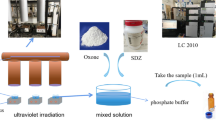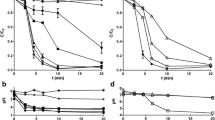Abstract
Under radiolytic conditions at a concentration of 0.1 mmol dm−3 the reactions of sulfamethoxazole, a worldwide used anti-infective sulfonamide antibiotic, were mainly induced by hydroxyl radicals. With a dose of 5 kGy complete degradation of aromatic system was observed. The sulfur of the molecule was entirely transformed to SO4 2–, while NO3 – and NH4 + were formed from the nitrogen content. The chemical oxygen demand and total organic carbon values indicated complete mineralization during irradiation. In pursuance of toxicity tests, the observed increase in mortality of Vibrio fischeri bacteria was mainly due to H2O2 formed during the radiolytic procedure. The results showed that the degradation was effective; therefore, the irradiation technology can be recommended for treatment of wastewater containing sulfamethoxazole.









Similar content being viewed by others
References
Petri AW Jr (2006) In: Brunton LL, Lazo S, Parker KL (eds) Goodman & Gilman’s the pharmacological basis of therapeutics, 11th edn. McGraw-Hill, New York
Finberg RW, Guharoy R (2006) Clinical use of anti-infective agents: a guide on how to prescribe drugs used to treat infections. Springer, New York
Drillia P, Dokianakis SN, Fountoulakis MS, Kornaros M, Stamatelatou K, Lyberatos G (2005) On the occasional biodegradation of pharmaceuticals in the activated sludge process: the example of the antibiotic sulfamethoxazole. J Hazard Mater 122:259–265
Ramaswamy J, Prasher SO, Patel RM, Hussain SA, Barrington SF (2010) The effect of composting on the degradation of a veterinary pharmaceutical. Bioresour Technol 101:2294–2299
Baran W, Adamek E, Ziemianska J, Sobczak A (2011) Effects of the presence of sulfonamides in the environment and their influence on human health. J Hazard Mater 196:1–15
Baran W, Sochacka J, Wardas W (2006) Toxicity and biodegradability of sulfonamides and products of their photocatalytic degradation in aqueous solutions. Chemosphere 65:1295–1299
Swedish Association of the Pharmaceutical Industry (2012) Environmentally classified pharmaceuticals. County Council, Stockholm
Daughton CG, Ternes TA (1999) Pharmaceuticals and personal care products in the environment: agents of subtle change? Environ Health Persp 107:907–938
Aronson JK (2006) Meyler’s side effects of drugs: The international encyclopedia of adverse drug reactions and interactions. Elsevier Science, Amsterdam
Jelic A, Gros M, Petrovic M, Ginebreda A, Barcelo D (2012) In: Guasch H, Ginebreda A, Geiszinger A (eds) The handbook of environmental chemistry: emerging and priority pollutants in rivers. Springer, Berlin
Bendz D, Paxeus NA, Ginn TR, Loge FJ (2005) Occurrence and fate of pharmaceutically active compounds in the environment, a case study: höje river in Sweden. J Hazard Mater 122:195–204
Xu B, Mao D, Luo Y, Xu L (2011) Sulfamethoxazole biodegradation and biotransformation in the water-sediment system of a natural river. Bioresour Technol 102:7069–7076
Kolpin D, Furlong E, Meyer M, Thurman EM, Zaugg S, Barber L, Buxton HT (2002) Pharmaceuticals, hormones, and other organic wastewater contaminants in U.S. streams, 1999–2000: a national reconnaissance. Environ Sci Technol 36:1202–1211
Loos R, Gawlik BM, Locoro G, Rimaviciute E, Contini S, Bidoglio G (2009) EU-wide survey of polar organic persistent pollutants in European river waters. Environ Pollut 157:561–568
Andreozzi R, Caprio V, Insola A, Marotta R (1999) Advanced oxidation processes (AOP) for water purification and recovery. Catal Today 53:51–59
von Sonntag C (2008) Advanced oxidation processes: mechanistic aspects. Water Sci Technol 58:1015–1021
Oller I, Malato S, Sanchez-Perez JA (2011) Combination of advanced oxidation processes and biological treatments for wastewater decontamination: a review. Sci Total Environ 409:4141–4166
Gonzalez O, Sans C, Esplugas S (2007) Sulfamethoxazole abatement by photo-Fenton: toxicity, inhibition and biodegradability assessment of intermediates. J Hazard Mater 146:459–467
Trovo AG, Nogueira RFP, Aguera A, Fernandez-Alba AR, Sirtori C, Malato S (2009) Degradation of sulfamethoxazole in water by solar photo-Fenton, chemical and toxicological evaluation. Water Res 43:3922–3931
Beltran FJ, Pocostales P, Alvarez PM, Lopez-Pineiro F (2009) Catalysts to improve the abatement of sulfamethoxazole and the resulting organic carbon in water during ozonation. Appl Catal B 92:262–270
Dantas RF, Contreras S, Sans C, Esplugas S (2008) Sulfamethoxazole abatement by means of ozonation. J Hazard Mater 150:790–794
Lin AYC, Lin CF, Chiou JM, Hong PKA (2009) O3 and O3/H2O2 treatment of sulfonamide and macrolide antibiotics in wastewater. J Hazard Mater 171:452–458
Rodayan A, Roy R, Yargeau V (2010) Oxidation products of sulfamethoxazole in ozonated secondary effluent. J Hazard Mater 177:237–243
Nasuhoglu D, Yargeau V, Berk D (2011) Photo-removal of sulfamethoxazole (SMX) by photolytic and photocatalytic processes in a batch reactor under UV-C radiation (λmax = 254 nm). J Hazard Mater 186:67–75
Kim TH, Kim SD, Kim HY, Lim SJ, Lee M, Yu S (2012) Degradation and toxicity assessment of sulfamethoxazole and chlortetracycline using electron beam, ozone and UV. J Hazard Mater 227–228:237–242
Spinks JWT, Woods RJ (1990) An introduction to radiation chemistry. Wiley Interscience, New York
Baga AN, Johnson GRA, Nazhat NB, Saadalla-Nazhat RA (1988) A simple spectrophotometric determination of hydrogen peroxide at low concentrations in aqueous solution. Anal Chim Acta 204:349–353
Weissberg A, Dagan S (2011) Interpretation of ESI(+)-MS-MS spectra–towards the identification of “unknowns”. Int J Mass Spectrom 299:158–168
del Mar Gomez-Ramos M, Mezcua M, Aguera A, Fernandez-Alba AR, Gonzalo S, Rodriguez A, Rosal R (2011) Chemical and toxicological evolution of the antibiotic sulfamethoxazole under ozone treatment in water solution. J Hazard Mater 192:18–25
Goncalves AG, Orfao JJM, Pereira MFR (2012) Catalytic ozonation of sulphamethoxazole in the presence of carbon materials: catalytic performance and reaction pathways. J Hazard Mater 239–240:167–174
Shende RV, Mahajani VV (1994) Kinetics of wet air oxidation of glyoxalic acid and oxalic acid. Ind Eng Chem Res 33:3125–3130
Acknowledgments
The authors thank the Hungarian Science Foundation (NK 105802), the Swiss-Hungarian project (No. SH7/2/14) and the International Atomic Energy Agency (No. 16485) for support. The assistance of Éva Kovács-Széles and Kornél Fél in ICP-MS experiments is greatly appreciated.
Author information
Authors and Affiliations
Corresponding author
Rights and permissions
About this article
Cite this article
Sági, G., Csay, T., Pátzay, G. et al. Oxidative and reductive degradation of sulfamethoxazole in aqueous solutions: decomposition efficiency and toxicity assessment. J Radioanal Nucl Chem 301, 475–482 (2014). https://doi.org/10.1007/s10967-014-3134-x
Received:
Published:
Issue Date:
DOI: https://doi.org/10.1007/s10967-014-3134-x




